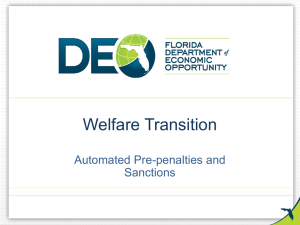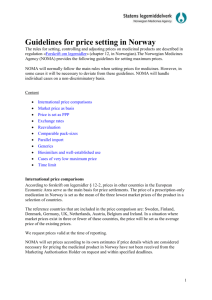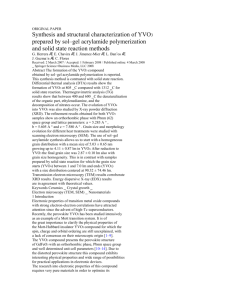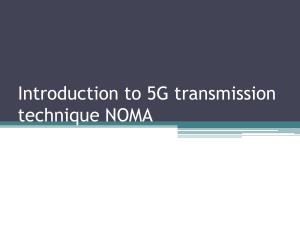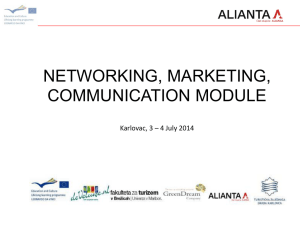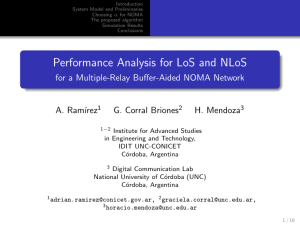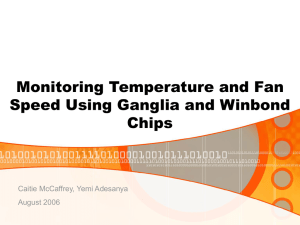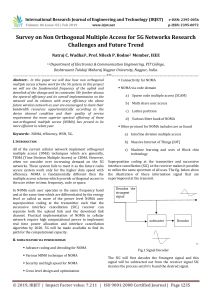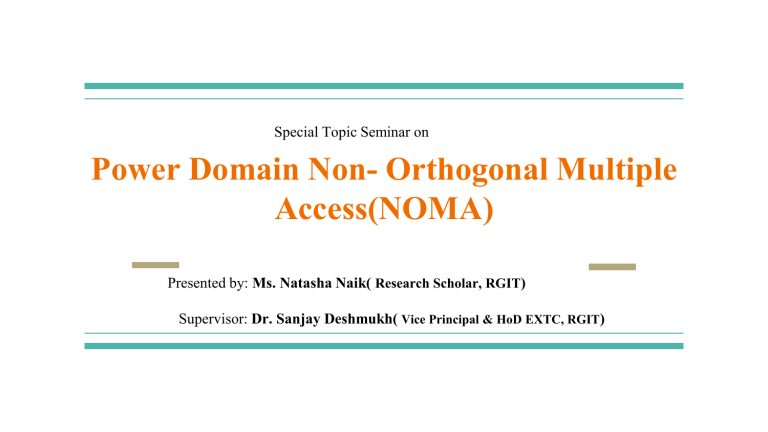
Special Topic Seminar on Power Domain Non- Orthogonal Multiple Access(NOMA) Presented by: Ms. Natasha Naik( Research Scholar, RGIT) Supervisor: Dr. Sanjay Deshmukh( Vice Principal & HoD EXTC, RGIT) CONTENTS INTRODUCTION TO NOMA WHY NOMA? OVERVIEW and MOTIVATION BASICS OF NOMA COMPARISON OF OMA AND NOMA NOMA SCHEMES UPLINK AND DOWNLINK NOMA NETWORK BASIC NOMA COOPERATIVE NOMA NOMA IN MIMO SYSTEMS CONTENTS ADVANTAGES OF NOMA DISADVANTAGES OF NOMA APPLICATIONS OF NOMA ACTIVE RESEARCH AREAS REFERENCES Features of Generations 1G 2G 3G 4G 5G Duration 1970-1980 1990- 2000 2004-2005 2011 Around 2020 Data rates 2kbps 64kbps 2Mbps 1Gbps >1Gbps Technologies Analog cellular,AMPS ,NMT Digital Cellular WCDMA,CDMA 2000, EDGE, UMTS Wi-Fi, WiMax LTE Unified IP seamless combination of broadband Service Analog voice no data service Digital voice, SMS,MMS Faster communication, Audio/Video data in better quality Wearable devices,mobile multimedia,dyn amic information access Wearable device with AI capability, 3D gaming, video streaming Multiplexing FDMA TDMA, CDMA CDMA OFDMA NOMA INTRODUCTION TO NOMA ● ● ● ● NOMA is an emerging technology for the fifth generation wireless networks which can address the requirements of 5G. The key idea behind NOMA is to serve multiple users with power multiplexing. NOMA brings a step change in data speed and a significant reduction in end to end latency. It uses Superposition coding at the transmitter and Successive Interference Cancellation at the receiver. Why NOMA? ● Orthogonal multiple access has been used during the past (1G-4G) as follows: FDMA/TDMA/CDMA/OFDMA. ● ● ● increasin To realize a better tradeoff between system throughput and user fairness a promising solution is to break orthogonality. NOMA serves more than one user on the same time and frequency resource. Overview and Motivation The next generation of wireless networks must support very high throughput, low latency, and massive connectivity. According to the international telecommunication union (ITU), 5G networks must fulfill several requirements including: (1) a minimum peak data rate of 10 Gbps (100 times more than that in the 3rd Generation Partnership Project (3GPP) Long-Term Evolution (LTE)) (2) a latency of 1ms (ten times lower than that in 4G networks), and (3) a connection density of 1,000,000 devices per km2 (100 times more than 4G networks) NOMA can address the above challenges of the next generation of wireless networks more efficiently than the conventional orthogonal multiple access schemes. Overview and Motivation Advantages Disadvantages OMA ● Simpler receiver detection ● ● ● Low spectral efficiency Limited number of users Unfairness for users NOMA ● ● ● ● ● Higher spectral efficiency Higher connection density Enhanced user fairness Lower latency Supporting diverse QOS ● Increase complexity of receivers Basics of NOMA ● ● ● ● ● ● ● All the users are served at the same time frequency and code. Exploits power domain multiplexing. Users with better channel conditions get less power. Successive Interference cancellation is used at the receivers. Superposition coding at the transmitter side. A pair of users can be served by NOMA if their channel gains are considerably different. Power allocation strategies play a pivotal role in capacity enhancement Comparison of NOMA with OFDMA Comparison of OMA and NOMA Superiority of NOMA over OMA Spectral efficiency and throughput User fairness, low latency, and massive connectivity Compatibility NOMA Schemes NOMA schemes can be classified into two types: ● ● Power-domain multiplexing Code-domain multiplexing. ● In power-domain multiplexing, different users are allocated different power coefficients according to their channel conditions in order to achieve a high system performance. In particular, multiple users’ information signals are superimposed at the transmitter side. At the receiver side successive interference cancellation (SIC) is applied for decoding the signals one by one until the desired user’s signal is obtained, providing a good trade-of between the throughput of the system and the user fairness. ● In code-domain multiplexing, different users are allocated different codes and multiplexed over the same time-frequency resources, such as multi user shared access (MUSA), sparse code multiple access (SCMA), and low-density spreading (LDS). Uplink NOMA Network Downlink NOMA Network Basic NOMA [1] Cooperative NOMA ● ● ● Similar to the basic NOMA, cooperative NOMA also uses a SIC receiver for detecting the multi-user signal. Therefore, the users associated with better channel conditions can be relied upon as relays in order to improve the reception reliability of the users suffering from poor channel conditions. For cooperative transmission, for example short-range communication techniques - such as Bluetooth and ultra-wideband (UWB) schemes - can be used for delivering signals from the users benefitting from better channel conditions to the users with poor channel conditions, which is the key difference with respect to the basic NOMA associated with SIC. NOMA in MIMO Systems [1] Advantages of NOMA ● ● ● ● ● NOMA offers higher spectral efficiency due to use of multiple users on same frequency resource. It provides massive connectivity by serving more users simultaneously at the same time. It provides lower latency due to simultaneous transmission all the time rather than dedicated scheduled time slot. It offers better QoS to all the users using flexible power control algorithms. The NOMA along with MIMO delivers enhanced performance. Disadvantages of NOMA ● Each of the users within the cluster need to decode information of all the other users even one having worst channel gains. This leads to complexity in the receiver. Moreover energy consumption is higher. ● If error occurs in single user due to SIC, decoding of all the other users information will be erroneous. This limits maximum number of users to be served by each of the clusters of the cell. ● In order to achieve desired functionalities of power domain concept in NOMA at the receiver, channel gain difference between users should be adequate. This limits effective number of user pairs served by clusters. ● Each users required to provide channel gain informations back to Base Station as feedback and hence NOMA is sensitive enough to obtain these measurements. Applications of NOMA ● ● ● ● Visible Light Communication: Similar performance gains as seen in the RF case can be expected if NOMA is implemented in VLC. As the channel generally does not change most of the time, the decoding becomes simpler. MIMO-NOMA: The combination of MU-MIMO which allows multiple beams and NOMA within a single beam can lead to a greater capacity of the system. Internet of Things: The scenario in IoT is massive connectivity. Exploitation of Non-Orthogonal resources as a means to enhance connectivity is subject to research. SoDeMA: Software Defined Multiple Access is an active research area where the best multiple access scheme is chosen based on the conditions of the system. For example, if we only have a small number of users and they do not have a large variance in SNR, OMA would be preferrable to NOMA. Active research areas • Power Allocation • Sum Rate maximization • Optimal User Pairing • Performance evaluation under various scenarios • Energy Efficient resource allocation REFERENCES 1. 2. 3. 4. Linglong Dai, Bichai Wang, Yifei Yuan, Shuangfeng Han, Chih-Lin I, and Zhaocheng Wang, Non-Orthogonal Multiple Access for 5G: Solutions, Challenges, Opportunities, and Future Research Trends,” IEEE Commun.Mag., vol. 53, no.9, pp. 74-81, Sep. 2015. Mojtaba Vaezi, Zhiguo Ding, H. Vincent Poor, "Multiple Access Techniques for 5G Wireless Networks and Beyond", 2019, ISBN: 978-3-319-92089-4. L. Dai, B. Wang, Z. Ding, Z. Wang, S. Chen and L. Hanzo, "A Survey of Non-Orthogonal Multiple Access for 5G," in IEEE Communications Surveys & Tutorials, vol. 20, no. 3, pp. 2294-2323, third quarter 2018, doi: 10.1109/COMST.2018.2835558 S. M. R. Islam, N. Avazov, O. A. Dobre and K. Kwak, "Power-Domain Non-Orthogonal Multiple Access (NOMA) in 5G Systems: Potentials and Challenges," in IEEE Communications Surveys & Tutorials, vol. 19, no. 2, pp. 721-742, Secondquarter 2017, doi: 10.1109/COMST.2016.2621116
